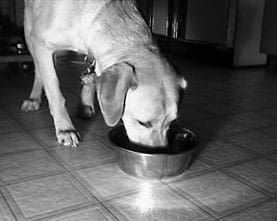As previously discussed in this column (“Who’s in Charge?” WDJ December 2000), the Association of American Feed Control Officials (AAFCO) is the single biggest organizational influence on the pet food industry in this country. Even though it is a non-regulatory, non-governmental voluntary agency, it is also comprised of the individuals who are most concerned with the production of pet foods – that is, state feed control officials as well as advisory liaisons from the United States Department of Agriculture (USDA), Food and Drug Administration (FDA), and the pet food industry, so most states adopt some or all of its rulings and regulations as law.
AAFCO meets twice a year to discuss developments in the industry and to hear requests for changes from its various constituents. These meetings are always interesting – at least, to those of us who are intensely interested in how the actions of this body can affect the food that gets eaten by the nation’s dogs and cats! The January 2001 meeting (which I attended) was typical in revealing the various pressures that the product – food for animals – is subject to by all the parties that have a financial stake in it.
For instance, numerous definitions were discussed at this meeting. How can a definition of a feed ingredient or feed description matter? Hey, in this business what you can call something is everything!
By any other name…
For example, in the January meeting, a new feed term, “Mechanically Separated Poultry, Feed Grade,” was sought by a single company, Ducoa, for a single product: defeathered, deboned, spent laying hens. “Spent hens” are worn-out egg layers, discarded by the egg industry before they reach their second birthday. Because they are bred to lay eggs, they aren’t meaty enough to be profitable when processed for human consumption. Up to now, they haven’t even been utilized much in animal feed or pet food, because it hasn’t been worth the cost to ship them to slaughter.
Ducoa proposes salvaging these spent hens for pet food through a newly developed process. First, the hens are fasted (to “clean out” their intestines), then killed by gassing with carbon dioxide. Feathers are scalded off, and the carcasses are centrifuged through a screen to separate the hard parts (bones, beaks, and feet) from the meat, viscera (internal organs), and other soft tissue. The resultant product will be treated with preservatives and antioxidants, chilled, packed, and shipped on refrigerated trucks. Ducoa has completed extensive testing to ensure that the product is free from bacterial contamination. The product is already nearing final approval by the FDA, although this is the first time it’s been presented to AAFCO.
While the finished product may be a good dog food ingredient, its new name poses a few problems for consumers. For one, the USDA already has a definition of “mechanically-separated poultry,” and it excludes viscera. Also, the current AAFCO definition of “poultry” does not include organs and by-products, but this definition of “poultry” does include organs and by-products. In addition, the “feed grade” part of the name is used only for the pet food makers’ information; once the product is included in the pet food, the term “feed grade” won’t be specified on the label of finished pet food. (In fact, no reference to grade or quality is allowed in a pet food ingredient statement at all.) So the label on the dog food will actually say, “mechanically-separated poultry,” which conflicts with the USDA definition.
Nevertheless, this definition passed on a vote of the committee, and will be considered by the full AAFCO membership in August. If it passes, it will be added to the 2002 book as a “tentative” definition, which is the initial status of all new definitions. It can be considered for official status next year.
In other poultry news…
The rendering industry was thwarted on its last two attempts to change the name of “by-products” to something more euphemistic. You see, it’s taken a while, but consumers have figured out what by-products are, and are avoiding foods that contain them. So, under the guise of “standardizing” the various animal product definitions, renderers asked the Ingredients Definitions Committee to approve two new definitions.
One proposed definition is “poultry protein,” which they would like changed to “the non-rendered product consisting of poultry tissues, including bone, exclusive of feathers, except in such amounts as might occur unavoidably in good processing practices.” Note that poultry “tissues” does not mean poultry meat. In essence, what this definition does is put a new name on “poultry by-products” and include bone.
Next, rendering reps asked to either generate a new definition for, or replace the existing definition of “poultry by-product meal” with the term “poultry protein meal.” This would be “the rendered product from poultry tissues, including bone, exclusive of feathers, except in such amounts as might occur unavoidably in good processing practices.” This is justified, say the proponents, because the current definition of “poultry by-product meal” excludes bones, while the definition of “meat and bone meal” clearly includes bones. The definition of “meat meal” does not specify whether it includes bones, but neither does it specifically exclude them.
The renderers evidently feel that all of this is just a terrible mess. It’s true that the only poultry ingredient that may include bones is “poultry meal.” The current definitions of “by-products” and “by-product meal” both exclude them.
AAFCO has twice denied similar petitions as attempts to confuse and deceive the consumer. However, the prior propositions were primarily cosmetic in nature. Initially, it appeared that this petition had a reasonable chance of success because it does make, in part, an actual change in the ingredient itself by including bones. Fortunately for consumers, the feed control officials are not likely to be fooled by the renderers’ newest proposal. The AAFCO Board directed the Iowa Feed Control Official to put together an expert panel to examine this issue in detail; if the definitions are to be changed, it appears, for now, that it will not be at the convenience of the rendering industry.
“Organic” dog food? Not!
The USDA recently approved guidelines for use of the term “organic” as applied to foods for human consumption. After several misguided attempts to include irradiated and sludge-fertilized crops (which drew a record number of citizen protests), a relatively good definition was eventually hammered out. The current USDA definition does not include pet foods; USDA evidently intends to include them at some future date.
In AAFCO’s January meeting, it was proposed that AAFCO accept the following reasonable-sounding definition of organic: “A formula feed or specific ingredient within a formula feed that has been produced and handled in compliance with the requirements of the USDA National Organic Program.” However, this proposal was met with great resistance from representatives of pet food companies, and, after much discussion, a decision on a definition was shelved in order to create a new “working group” that would direct further discussions on the topic in the future.
Why should it be so hard to accept such a simple definition? Because, if the whole product is to be labeled “made with organic ingredients,” the new USDA rules require at least 70 percent of the finished product to consist of organic ingredients. This means that pet food makers using organically raised meat, for instance, but no other organic ingredients, will not be able to say “made with organic meat” on the label. At least one pet food company has interpreted this to mean that they won’t be able to use any organic ingredients at all – because who will pay extra for organic ingredients if they can’t brag about it on the label?
For now, given that there is no accepted rule, pet food makers can still say anything they want regarding their organic ingredients on the label, as legal counsel has opined that pet food does not fall under the current definition, and USDA concurs.
Natural? You make the call!
The Ingredient Definitions Committee passed a new tentative definition for “natural.” That is: “A feed or ingredient derived solely from plant, animal or mined sources, either in its unprocessed state or having been subject to physical processing, heat processing, rendering, purification, extraction, hydrolysis, enzymolysis or fermentation, but not having been produced by or subject to a chemically synthetic process and not containing any additives or processing aids that are chemically synthetic except in amounts as might occur unavoidably in good manufacturing practices.”
What the heck does all that mean? Not a whole lot. This definition does little to restrict products that most of us would not consider truly natural. For instance, a substance could be extracted from a plant using acetone or other chemical, but as long as most of the chemical is evaporated or rinsed off, the substance could still be called “natural.” The limitation of “good manufacturing practices” does not reassure me. The regulations adopted by AAFCO require only “reasonable” procedures to prevent “unsafe” contamination (not quite the same as “zero” contamination).
Plus, exceptions and disclaimers will be allowed for things like “natural cheese flavor” on a product, even if none of its other ingredients meet the definition. Synthetic vitamin and mineral mixes can be used in an otherwise “natural” food if the label states “Natural with added vitamins, minerals and other trace nutrients” – and the qualifying statement must use print only half the size of that used for the word “Natural.”
Under this definition, animal digests, solvent-extracted meals, and other foods that undergo man-made chemical processing, may still be labeled “natural.” For instance, a product like “Soybean meal, dehulled, extruded-expelled” could now be considered “natural.” What is it really? “The meal product resulting from grinding the cake after removal of most of the oil by mechanical extraction method preceded by dry extrusion at 300-320°F of dehulled soybeans.”
The approved definition is, at this point, in “tentative” status; it will most likely be approved as is by the full AAFCO membership at its August meeting.
The bottom line? In our opinion, label claims really don’t give consumers much useful, dependable information, and should not necessarily influence you to either buy or not buy a given food. While state feed control officials, by and large, are in the consumers’ corner (as opposed to being in the industry’s pocket), their ability to protect us and our dogs is under constant assault by the profit-motivated industry. Buyers must always beware.
-By Dr. Jean Hofve, DVM
Dr. Jean Hofve is the Companion Animal Program Coordinator for the Animal Protection Institute, located in Sacramento, California.





